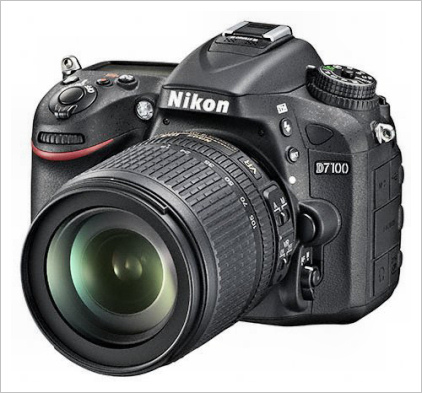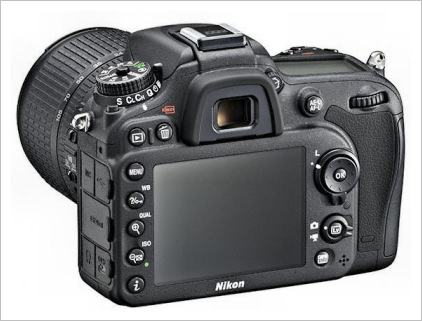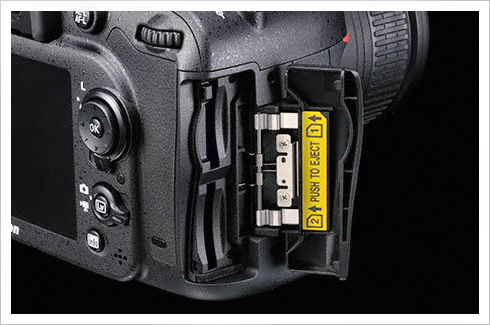

Nikon D7100 24MP APS-C DSLR

Nikon D7100 24MP DSLR
Today Nikon fired a shot across Canon's bow. The Nikon D7100, a 24MP DX (APS-C) sensor "enthusiast" DSLR body for $1199.95
So what does The Nikon D7100 have? Well, for a start:
- All new 24.1 MP APS-C sized CMOS sensor
- 1080 HD video at 24/25/30/50/60 fps
- 100% viewfinder
- 51 point AF system (15 cross type)
- -2EV AF sensitivity
- 2 to 5 frames in steps of 1/3, 1/2, 2/3, 1, 2, or 3 EV exposure bracketing
- AF at f8 with center AF zone
- ISO 100-6400, expandable to 25,600
- 6fps at full frame resolution
- 7fps in 1.3x crop mode (15.4MP resolution)
- 53ms shutter lag
- Dual SD card slots (UHS-1 and SDXC compatible)
- 1,228,800 dot high-res 3.2" LCD
- OLED data display in viewfinder
- Spot white balance
- 3D Color Matrix Metering II (2,016-pixel)
- 150,000 cycle shutter (1/8000s, 1/250s sync)
- Dust and Moisture resistant construction
- No Low pass filter in front of sensor
Adorama is currently accepting pre-orders. The D7100 is expect to start shipping around March 21st
- Nikon D7100 body - $1196.95 - Adorama
- Nikon D7100 with 18-105mm f/3.5-5.6G ED VR DX Lens - $1596.96 - Adorama

Nikon D7100, 3.2" 1,228,800 dot LCD
The Nikon D7100 is clearly going to be the competition for either the long expected Canon EOS 7D MkII or an EOS 70D, both which I expect to see announce sometime this year. Nikon have experience with small pixel sensors since they've gone to 36MP in their full frame DSLRs (as well as 24MP in the D3200) and the D800E gives them experience with dealing with the effects of not having a low pass filter in front of the sensor. Actually 24MP DX sensors have the same pixel size as a 54MP full frame sensor would so it will be interesting to see what the noise level and dynamic range of the D7100 sensor is and if it's an improvement over that of the the D3200. The recent 36MP sensors have very, very good low ISO dynamic range (see my test of the D800 here).
Leaving out the optical low pass filter in front of the sensor is a bold move, but again Nikon have experience with that on their 36MP full frame Nikon D800E. Actually the D7100 goes a step further. The D800E has a low pass filter, but it also has a secondary "anti-low pass" filter which cancels out its effect. The D7100 leaves out the LPF altogether. The result of that is increased sharpness, but at the cost of moire fringing (colored patterns) on fine detail due to aliasing of high frequency components of the image. This can partly be dealt with in software and I'm guessing it's something that Nikon must have been working on.

Double SD card slots
The D7100 1.3x mode is interesting, though I guess not super exciting for still work. It's a 1.3x crop of the APS-C format size from 24MP to 15MP so it changes the "lens multiplier" from Nikon's normal 1.5x (Canon is 1.6x) to 2x, the same as the micro 4/3 format. It's actually the area covered by the AF zones in the Nikon D7100. Of course you could just shoot the full APS-C frame, but in the 1.3x mode the files will be smaller and the maximum frame rate goes from 6fps to 7fps. Slightly more interesting is that it can be used in video mode. In video mode the image is downsized anyway, so it really doesn't matter much from a resolution viewpoint whether you start out at 24MP and APS-C or 15MP and a cropped APS-C. Either way you end up with a 1920 x 1080 image. So in that situation you do actually get a useful multiplication of focal length.
An $1199.95 MSRP is very competitive. The EOS 7D is currently selling for around $1450 so it's hard to see a 7D MkII selling for less, and if it has to compete with the Nikon D7100 at under $1200, Canon clearly have an issue to deal with. Perhaps the answer to that issue might be an upgrade of the 60D to a 70D. Since the 60D can be found for a street price as low as $700, Canon could make substantial upgrades to it and still match Nikon's $1200 price on the D7100. As for a 7D MkII, Canon put GPS and WiFi in the full frame 6D which sells for under $2000, so maybe they'll do the same with the 7D MkII to add more value and move it into a class higher than any of the Nikon crop sensor (DX format) DSLRs. I guess we will have to wait and see on that one.
Nikon USA have referred to the D7100 as their "flagship" DX format camera in much the same way as Canon call the EOS 7D their "Flagship" APS-C format camera. That seems a little odd for a $1200 body. I guess that may also mean that Nikon are dropping the D300s (which was their "flagship" DX format body). There is a report that Canon Europe have denied that the D300s is being dropped and that the D300s is still the flagship DX camera, so I guess Nikon need to get their stories straight! As of 02/25/13, the Nikon USA website still refers to the D7100 as "...The new flagship of Nikon's DX-format HD-SLR lineup..."
Here's what Nikon have to say about the D7100:
Adorama and B&H are currently accepting pre-orders. The D7100 is expect to start shipping around March 21st
- Nikon D7100 body - $1196.95 - Adorama
- Nikon D7100 with 18-105mm f/3.5-5.6G ED VR DX Lens - $1596.96 - Adorama

“Solidifying Nikon’s ongoing commitment to the DX-format D-SLR customer, the innovative D7100 provides new ways for photographers to capture their creative vision with incredible detail and precision, whether through still images or HD videos,” said Bo Kajiwara, Vice President of Marketing, Planning and Customer Experience, Nikon Inc. “The D7100 blends the best creative features with advanced-level functionality to give the enthusiast exactly what they want– and that’s a great shooting experience before, during and after capture, from shooting to sharing.”
Engineered for Exceptional Image Quality At the core of the Nikon D7100 is a new 24.1-megapixel DX-format CMOS sensor, designed to render the truest, most detail-rich images possible and brilliant HD video. The innovative sensor design delivers the ultimate in image quality by defying convention; because of the high resolution and advanced technologies, the optical low pass filter (OLPF) is no longer used. Using NIKKOR lenses, the resulting images explode with more clarity and detail to take full advantage of the 24.1-megapixel resolution achieved with D7100’s DX-format CMOS sensor.
Driven by Nikon’s exclusive EXPEED 3 image processing engine, the D7100 realizes a focus on image quality that extends beyond staggering sharpness to outstanding images with a wide dynamic range in a variety of lighting conditions. A wide ISO range of 100-6400 (expandable to Hi-2 of 25,600) allows for more versatile shooting to capture challenging conditions such as nature at twilight or even sports under less-than-ideal lighting. Even at higher ISOs, noise is minimized for both still images as well as when recording HD video.
Performance and Features Geared for the Advanced User The Nikon D7100 is designed for the experienced shooter ready to take their photography to the next level, who demands a camera that conveys reliability and performance, and who is eager to embrace the next photographic challenge. These features include:
New 51-Point AF System - The D7100 features Nikon’s professionally proven and lightning-fast 51-point AF system, with a new Multi-CAM 3500DX AF module. Additionally, the AF system and exposure are augmented with Nikon’s 3D Color Matrix Metering II 2,016-pixel RGB sensor and Scene Recognition System, which recognizes the scene prior to shooting in order to adjust AF, AE, AWB and other parameters. The results of this system are accurate and even exposures, sharp details and vivid color, frame after frame. For additional precision, 15 of the 51 AF points are cross-type, and the center point is functional at f/8, giving DX photographers an additional telephoto advantage when using a teleconverter.
Rapid Response and Operation - To help ensure the decisive shot is not missed, the D7100 can shoot at up to six frames-per-second (fps) at full resolution and up to seven fps when using the new 1.3x crop mode at slightly reduced resolution. Overall operation and image processing is swift, while startup and shutter lag is nearly imperceptible with a release time lag of 0.052 second (CIPA). Image data is also written to dual SD card slots, which accept the latest high-speed UHS-1 and SDXC cards.
1.3x Crop Mode - Sports photographers take note: Building upon the telephoto benefits of the DX-format, the D7100 has the unique ability to shoot in a 1.3x DX crop mode for both stills and HD video. While in this innovative mode, shooters will gain an extra telephoto boost (2X), and a boost in burst speed to seven fps, with 15.4- megapixel resolution. Additionally, while in this mode, the 51-point AF array covers more of the frame, allowing improved subject acquisition and tracking performance through the viewfinder.
New High Resolution LCD - The new, wide and bright LCD screen is 3.2-inches and features a super high resolution of 1,229K dots. Now photographers can easily compose and check critical focus for HD video.
New Viewfinder - Nikon has implemented a bright and high-contrast new OLED data display within the optical viewfinder that makes it easier to read and see shooting data. When composing through the viewfinder, users see 100% frame coverage, essential for proper framing.
Spot White Balance - A new feature for Nikon cameras, Spot White Balance allows for quick and precise white balance adjustment while shooting in live view. By selecting a desired point on the screen, users can set a custom white balance from a distance, even while using a super-telephoto lens. This is helpful for shooting video or when shooting under unfamiliar lighting when no gray card is available.
Durable Construction - Built to perform in a wide variety of conditions, the D7100 is built to the same moisture and dust resistance specifications of the venerable Nikon D300S. For durability, the top and rear covers are constructed of magnesium alloy, while internally, the shutter has been tested to withstand 150,000 cycles. Despite its robust construction, the camera remains lightweight, weighing in at approximately 1.5 pounds (body).
Enhanced Interface - To make it easier for users to quickly access frequently used functions, the “i” button has been added to the enthusiast-oriented control layout on the camera.
Sharing and Remote Shooting Simplified Photographers know that moment when the shutter clicks and they have created something stunning which deserves to be shared. No matter where that moment occurs, whether in an urban landscape or isolated forest, they can now share their images wirelessly by an attached WU-1a Wireless Mobile Adapter.1 With this optional adapter the user has the ability to share images to a supported smartphone or tablet, shoot remotely from their device, and transfer photos from up to 49 feet away. The Nikon Wireless Mobile Utility application is available free of charge on Google Play™ for Android™ devices or from the App Store™. When using the application, photographers can wirelessly transfer images from the camera to a mobile device and even remotely control the camera.
Capture Exceptional HD Video For those looking to create multimedia content, the Nikon D7100 has a wide variety of innovative features for capturing HD video at various frame rates. With a press of the dedicated video record button, video can be recorded at 1080/30p, or at 60i/50i (in 1.3x Crop Mode) for optimal playback on many HDTV’s when connected via HDMI. The D7100 also provides the ability to record stereo sound through the internal microphone, or attach an optional external microphone such as Nikon’s ME-1, through the dedicated microphone terminal. To reference audio, the camera also features a headphone terminal. Users can also get creative using Nikon’s Creative Effects in real time. This feature lets users take advantage of modes like Selective Color or Color Sketch to create truly customized movies.
Full Control, Creatively In addition to full manual controls, the Nikon D7100 features a variety of intelligent modes to create effects and special features so that users can unleash their creativity. Nikon’s Picture Controls can be applied to photo and video to change the color, tone and saturation of an image for creative control. When capturing still images, the same Creative Effects modes and filters available in video are also at the disposal of the user. By combining consecutive frames, the D7100 also has a high dynamic range (HDR) function to let users capture photos with a vast tonal range.
NIKKOR, Speedlight and System Compatibility For 80 years, the NIKKOR legacy has been providing world renowned optics for photographers. The D7100 is compatible with Nikon’s dedicated DX-format lenses and more than 50 FX-format lenses. NIKKOR lenses offer the ultimate in sharpness and clarity in photos and HD video. For added versatility, the camera features a built-in flash, or can act as a commander in Nikon’s popular Creative Lighting System (CLS).
WR-1 Transceiver In addition to the D7100, Nikon also announced the WR-1 Transceiver for Nikon D-SLR cameras. This device uses the 2.4 GHz radio frequency for maximum range when communicating with the camera, extending the range and functionality2 for remote shooting applications. The communication range between WR-1 units is approximately 394 feet3, and 15 channels are available. Users also have the ability to remotely control a camera (with a WR-1 used as a receiver) attached by operation of another WR-1 (used as a transmitter), and also perform simultaneous or synchronized release of shutters on several cameras using the WR-14. Furthermore, there are a wide variety of options for remote shooting, which include dividing remote cameras into groups and controlling each group separately and interval timer photography. Remote shooting by combining the WR-1 with WR-R10/WRT10 wireless remotes is also possible5.
Price and Availability The Nikon D7100 will be available starting in March 2013 for the suggested retail price (SRP) of $1599.95* with the AF-S DX NIKKOR 18-105mm f/3.5-5.6 VR lens or $1199.95 for the body only configuration. Additionally, the new MB-D15 battery grip and the WR-1 transceiver will also be available in March 2013, and pricing for these products is not yet announced. The WU-1a Wireless Mobile Adapter is currently available and has a suggested retail price (SRP) of $59.95.